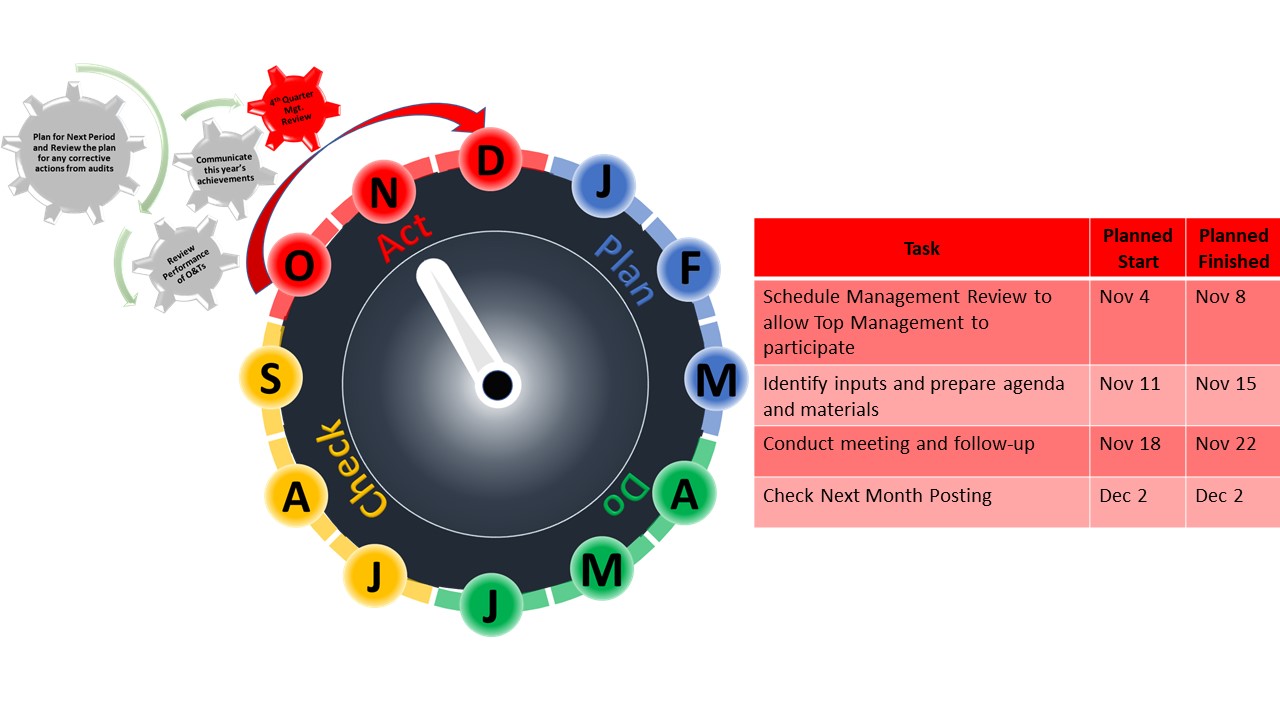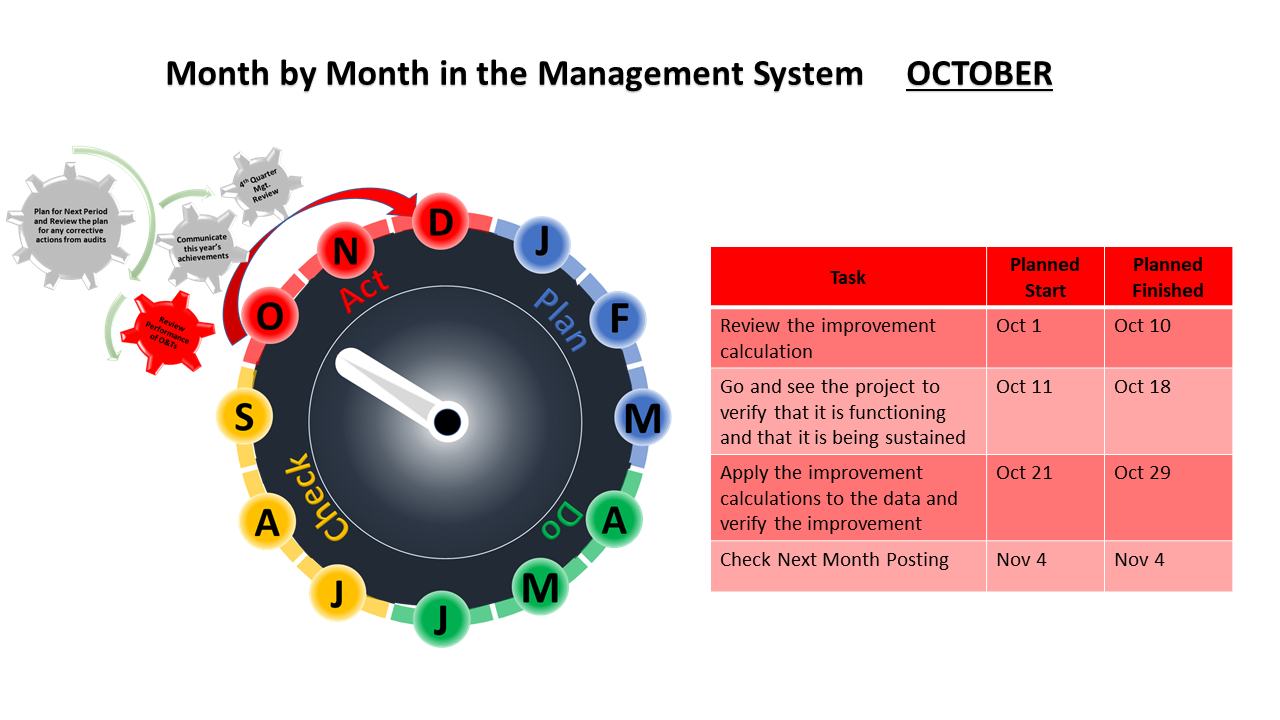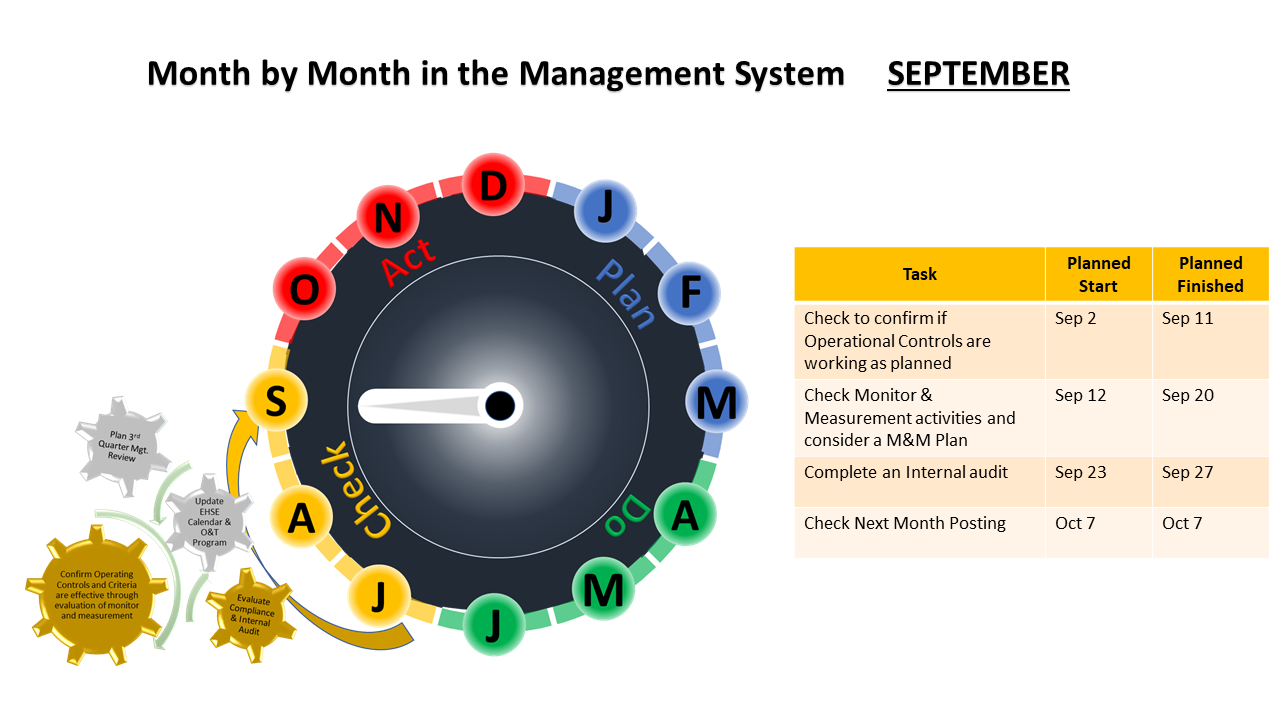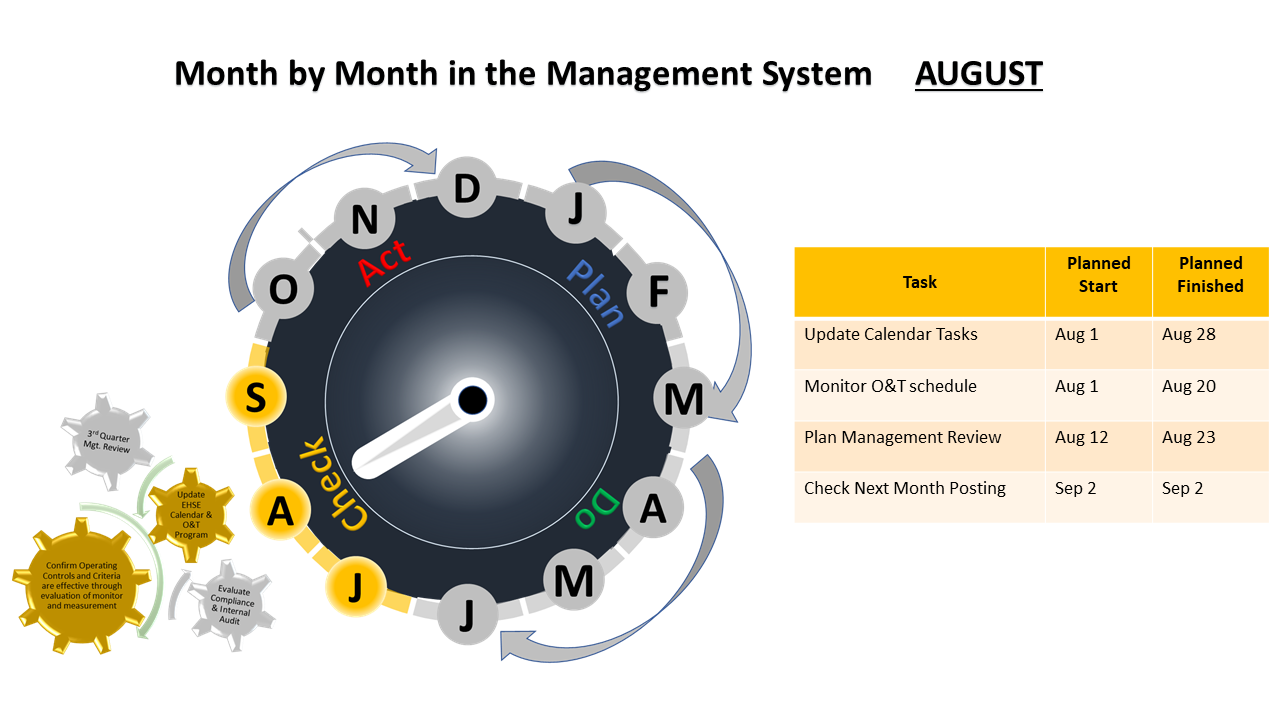Posts by Lynn McIntosh
March; the clock is ticking
When the long-awaited ISO 45001 standard was published in 2018, the amount of time to either implement or upgrade from OHSAS 18001 seemed like an eternity. Three full years to upgrade, “No problem” said many organizational leaders. Now we are nearing the end of the three years, and organizations are rapidly trying to understand how to quickly upgrade or implement and beat the clock.
If this is your organization, this post is for you. While this is a new standard, the original intent established in OHSAS 18001 is the same. Both standards use a management system framework designed to prevent work-related injuries and to provide safe and healthy workplaces.
There are important differences in ISO 45001 as a result of its focus on health and safety performance. While it is not presented strictly as a performance standard, continual improvement is a shall requirement. As a result, it improves from OHSAS 18001 in two key areas – proactive risk management and worker involvement.
ISO 45001 requires assessing and controlling risks versus hazards. It also adds the requirement to address opportunities to further improve performance. Adequately evidencing a pro-active and ongoing assessment process is challenging. Ongoing and proactive is a key shall requirement within the standard. Organizations will need a methodical and dependable tool which will capture the original and subsequent assessments. Whether you use paper or software, ensuring the assessments are reflective of the employees performing various tasks is key.
While the standard does not specify assessor “qualifications”, dependable assessments rely on competent resources. Choosing assessors across relevant levels and functions in the organization offers some advantages First there is an opportunity to expand knowledge of workplace hazards and risks from those employees performing assessments. More employees gain more knowledge about hazards and risks, and then avoid their own unsafe acts, identify unsafe conditions, setting an example for others to follow. This can be one meaningful way an organization can incorporate participation and consultation with employees and contractors. The organization who delivers meaningful training for new assessors on the risk analysis methodology and tools and calibrates assessors periodically likely will gain the most benefit. The participation and consultation requirement is a big change from OHSAS 18001 and incorporating employees and contractors into risk analysis provides valuable input, and the other benefits as described above.
In addition to risk assessment involvement, workers have other opportunities for participation including involvement in objectives and targets, management of change, incident investigation, and internal audit.
If you are contemplating your action to upgrade from OHSAS 18001 or implement ISO 45001, action on risk analysis with participation and consultation will help you achieve conformance and make your system more proactive. The clock is ticking as the ISO 45001 standard was published on March 12, 2018. The three year milestone is upcoming March 12, 2021. This is the year for action!
January 2020 Think Shared Water Challenges
Happy New Year!
We were thinking about the 2020 Blog and could not ignore visibility needed for water management. The updated Alliance for Water Stewardship (AWS) Standard 2.0 provides significant guidance for those organizations ready to contribute to addressing shared water challenges. Almost no matter where you are positioned, it’s hard to ignore water is a shared challenge amongst business, neighbors, local governments, and interest groups. There are a variety of water challenges, some of which include: floods, droughts, lack of access to clean water and sanitation, the need for more efficient use and discharge. We all need it and it is not always present in the right amounts in the right place and in the appropriate quality.
Organizations have traditionally worked independently to attack water-related issues. While these initiatives have resulted in efficiency and/or quality improvements, they are often limited in scope. There are numerous published articles indicating the next level of involvement is to expand sustainability efforts outside of the organization proper. There is a need to collaborate and partner with stakeholders. This is prescribed in the AWS standard and is a great way to address the shared water challenge.
For those organizations with an Environmental Management System, it can start with the process to enhance how aspects and impacts are identified and evaluated. Just as we use risk assessment to prioritize health and safety issues, there is a place to apply this same process for environmental aspect purpose. Many organizations already use generic frequency, severity, and probability as “risk” criteria, but we see more organizations initiating a more robust analysis. A first step, consider upgrading your process to change how you evaluate and value water and shared challenges to gain greater visibility:
- Include the views of interested parties in scoring. It’s the internal and external stakeholders who may not only have an interest but share in a challenge. Look outside at how a shared challenge impacts or is impacted by the organization.
- For example, the organization physical boundary is a named river or creek. The organization does not have a discharge point, but stores materials near the boundary. Local government has established nature trails and the corridor is now a designated interest for a Friends of the River Trail. They are active in preserving and improving water quality.
- Consider the impacts on quality of water. Does the material storage have release or emission potential? Consideration is given not only to potential to exceed regulatory thresholds, but also how it impacts the community associated with storm water runoff. Material storage could impact water quality if released, but also may impact the aesthetics associated with a “natural area”.
- Consider the impacts on quantity of water used. Because of the ready availability of low-cost, high-quality water and availability of municipal infrastructure in many places, there has been little incentive to reduce wasteful uses. However, there is an increasing demand on water supplies and need to reduce the strain on municipal water infrastructure. Water uses could be ranked by their opportunity for improvement including reducing water losses (leaks), increasing water efficiency of fixtures, equipment and process and reusing water that would otherwise be discarded or discharged.
Use 2020 to consider shared challenges and how to make a meaningful impact in taking action.
December Holiday Post
Organizational complexity and change can make it challenging to adhere to management systems for workplace safety, environmental, energy, water stewardship and responsible electronics recycling. At EHSE Management Solutions, we believe those management systems are the best way to overcome those challenges and achieve continual improvement. Throughout the year, we have posted new tasks and our ideas for management systems. Our intent is to help you improve your system, ease your burden, and increase your comfort level your system is conformant to required standard(s). Thank you for your feedback and keep it coming.
We close out the year with a few thoughts for the new year:
- For those of you still certified to OHSAS 18001 and ISO 50001:2011, please note the migration deadline and don’t wait. Certification bodies are required to stop performing audits under the prior standard 18 months after publication date. This means that you need to migrate in 2020.
- Water, like climate, is a shared resource with both physical and non-physical business risks and, despite being a part of ISO 14001, is increasingly subject to more focused attention under its own managed system. The Water Stewardship Standard 2.0 might deserve your consideration for implementation if you have or are contemplating water conservation goals, or want to be part of this global movement.
No matter what holiday you celebrate, we wish you the best and look forward to continued collaboration and communication with you in the new year.
In the meantime, feel free to reach out if there are any questions or needs as you contemplate your 2020 activities.
Audrey and Lynn
November Management System Tasks
The last management review of the year is due. Management Review is often underutilized because it is viewed as an annual event and not a process. Many organizations have found that more frequent Management Reviews result in new or modified actions which help achieve continual improvement. Get the greatest benefit from Management Review through the combination of the following:
• Top Management Involvement. How will you spend the time with senior leadership? Planning for management review to include discussion and decisions will bring real benefit to the business.
• Input Identification. You can look in the standards and get the list of inputs. Make sure to include how the management system integrates with the strategic direction of the business. This is often an overlooked input. Take some time to be sure for this last management review you have addressed all the inputs at some time during the year
• Forward Meeting Focus. Make sure the meeting is not just a review of past activities and results. Use the inputs to stimulate discussions that drive future actions and goals and identify opportunities for improvement.
• Output Follow-up. The actions you take afterwards from the discussion in Management Review are important. After the Management Review meeting, review your meeting minutes and ensure any corrective or preventive action items are identified with both due dates and responsible person and send the Management Review meeting minutes to attendees to confirm the results of the meeting, action items and responsibilities.

October Management System Tasks
It’s the last quarter of the year, and no better time to analyze objective and target performance and plan for 2020. Let’s use October for Performance Evaluation. Why? It’s near the end of the year and some part or all of the objectives planned needs to be achieved soon Additionally, this information is needed for 4th quarter Management System Review as it is one key ingredient to leadership understanding performance and making decisions for continual improvement. With this last performance evaluation, the verification of savings can be completed for all the finished projects. Why verification? The standards now all specify some evaluation of performance.
The evaluation should include these steps:
Review the savings calculation. For example: ABC Company has set an objective to Reduce Waste to Landfill. The project is to reduce 50% of waste sent to landfill from a baseline year in 2018. The goal to reduce 250 tons would be achieved by September 30, 2019 through waste refusal and recycling. The program included two activities:
-
- Waste Refusal – Wooden Pallets are banned and suppliers are supplied with returnable pallets
- Improved segregation for recycling of plastics and cardboard, and identification of two new areas where plastics and cardboard could be recycled.
The program completed on September 30. Let’s see how ABC Company did. As the verifier, you are provided with the objective and target statement identified above and the worksheet showing the amount of waste refused or recycled. You are now on the path of savings verification.
1. The savings calculation claim: ABC Company determined: waste refused totaled 150 Tons + waste recycled is 150 Tons = 300 tons of waste refused and recycled.
2. Go and see the project to verify that it is functioning and is sustained.
-
- The new waste segregation process is visible and employees know correct segregation. A contractor is observed loading the recycling roll-off with the proper recyclable material. The contractor taking recyclables is an approved vendor. Records show plastic caps are recycled into school desks and chairs and cardboard is recycled to a nearby paper mill.
- The Warehouse Manager is stacking wood pallets when you arrive. She tells you, the returnable pallets are not performing as planned. A return to wood pallets happened 2 months ago for the two largest suppliers. In the 2 months of the return to wood pallets 30 tons were shipped waste to landfill.
3. Apply the savings calculation to the data and verify the savings. Make sure your worksheet shows the savings calculation and the calculation is reviewed during management review. For this project:
150 Tons Recycled + 120 Tons Refused (150 Tons claimed – 30 Tons sent to landfill) = 270 Tons. To meet the goal 250 tons of waste needed to be recycled or refused. Is the goal met? The short term goal is met, but the problem with the returnable pallets must be solved in order to sustain the objective. There is more work to do.
What if you find the project is not finished? Whether it is due to insufficient planning, changing business conditions, or some other unforeseen factor, the organization needs to take action. This is time for action by re-planning the project to ensure you measurable continual improvement and the improvement is sustained. Don’t forget to discuss this during 4th quarter Management Review. There is certainly discussion on how to avoid for next year.
September Management System Tasks
September
Fall is here and as you get closer to 4th quarter, it’s time to finish taking care of this year’s business. There are three important checking activities:
Operational Controls – Are they working?
It’s easy to set up work instructions, standard operating procedures, signs, etc….but are they controlling the unintended impacts they were set up to control? For all the work to set up a thorough control, it’s worth the time to check effectiveness. Do this ahead of the internal audit and prior to your evaluation of monitor and measure so you close up any obvious gaps.
Going forward the checking of operational controls is part of the PDCA when controls are set.
- Plan the control needed – For example, an SOP for separating and stacking cardboard (a key characteristic) on the shop floor
- Do by documenting the control – Review accuracy with the shop floor, and then train affected employees and contractors to follow it. Do both the Supervisors and operators say the proposed SOP for cardboard will work? Do they understand the intent?
- Check by reviewing the operation – Verify if the SOP is followed and all affected cardboard is separated and stacked as planned. Make sure you evaluate the methods to track amount of cardboard separated and stacked so the monitor and measure for this key characteristic is established.
- Act by reporting on the performance – Are there other improvements to the SOP you can plan or are there improvements to how cardboard is collected?
Monitor and Measurement – Are you following a plan?
The monitor and measurement of key characteristics associated with the system is really one of your last checking activities. In our experience organizations benefit greatly from the documented monitor and measure plan because the standard requires:
- What will be monitored
- How will it be monitored
- How will performance be measured
- When will it be monitored/measured
Remember to identify the Role/Responsibility for completing tasks
- Is there a plan for monitor and measure; simply stated; have you systematically identified the list of characteristics to monitor and measure to achieve the intended goal of continual improvement. If this is not part of the system, make a list and describe how each item is monitored and measured. Most importantly list what is considered a deviation and how is it addressed?
- Check the calibration and preventive maintenance system. Is new or replaced equipment adequately identified? Is key equipment, devices, and gauges calibrated? Do work orders function as planned? When employees or those working on behalf indicate an environmental or safety situation exists does the TAG or request follow a process for timely completion.
Internal Audit – Is it rigorous, independent and up-to-date?
The internal audit should follow the arrangements of the internal audit program. Your internal audit program needs to address frequency, audit methods, planning, reporting, the importance of the business processes and the results of previous audits. Don’t forget for ISO 45001 the need to include consultation arrangements into the audit program.
A robust internal audit program is key; so take the time to plan, schedule auditors and give it the attention it deserves. The results of the internal audit should show you the strengths and any weaknesses in the system. If the conclusion of the audit identifies a need for action, a robust program includes the organization commitment to investigate those weaknesses to prevent recurrence.
Periodically use a fresh pair of eyes. There are any number of ways to do this including inviting a sister organization to audit, using an outside auditor, or simply having new auditors in your organization qualified and given the audit task. Don’t be stuck on “if it wasn’t found before, it cannot be a legitimate audit finding”.
Finally, if the internal audit checklist has not been reviewed and updated, it’s time to ensure all the criteria for the audit meets all of the requirements in the standards and the procedures. While any checklist has to be manageable, it’s likely if the checklist hasn’t been reviewed, it may not address the newest requirements for ISO 14001, ISO 45001, and ISO 50001. Now is a good time for the audit team to gather, review the checklist and recommend improvements.

August Management System Tasks
August is time to dig into checking on performance.
Update your calendar and ensure all of your compliance obligations are on track.
Objectives and Targets should be nearly completed or complete. Take the time to understand any obstacles for success.
Once you understand performance, plan the 3rd quarter management review. Make sure you plan for reporting on performance and the discussion points to ensure strong participation.
Plan and complete August tasks using the calendar to the right of the management system clock







